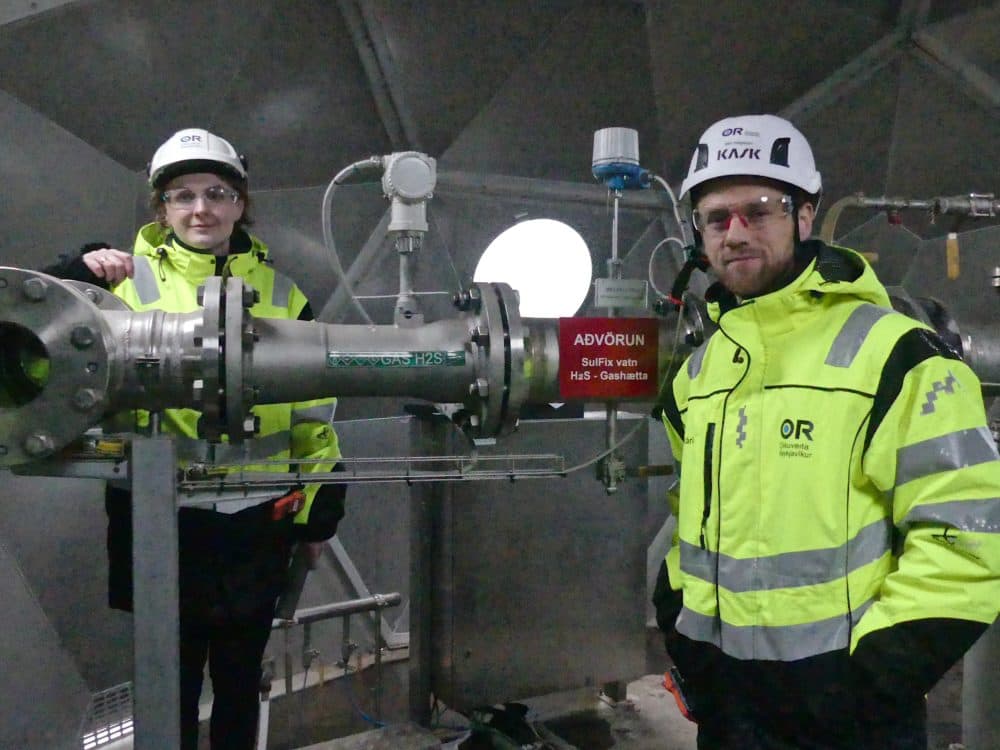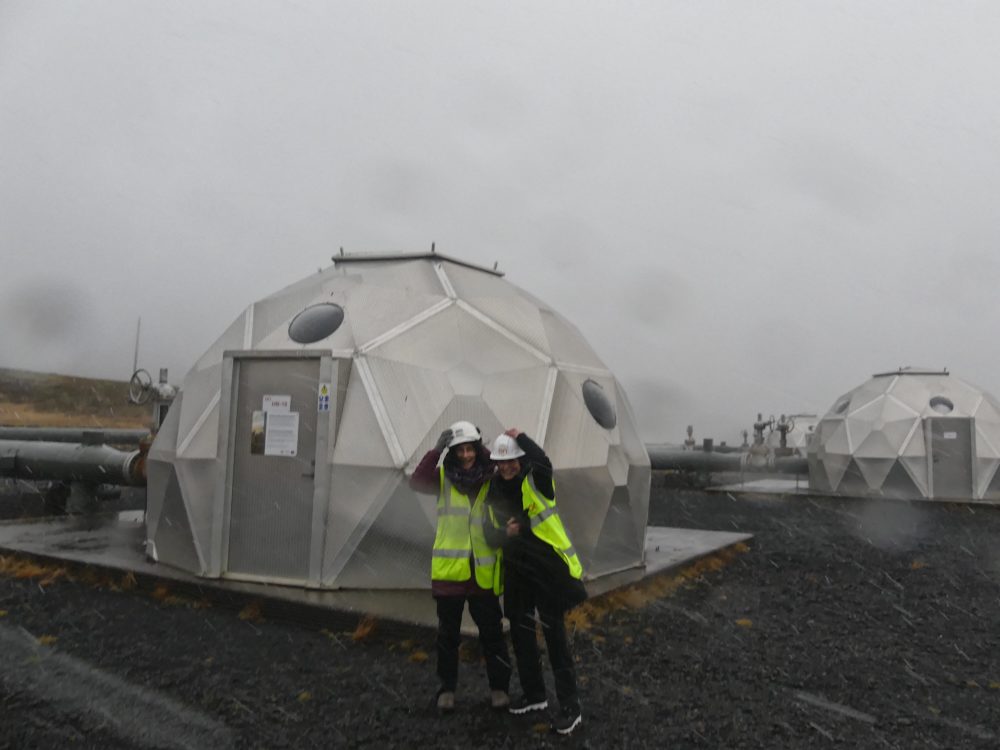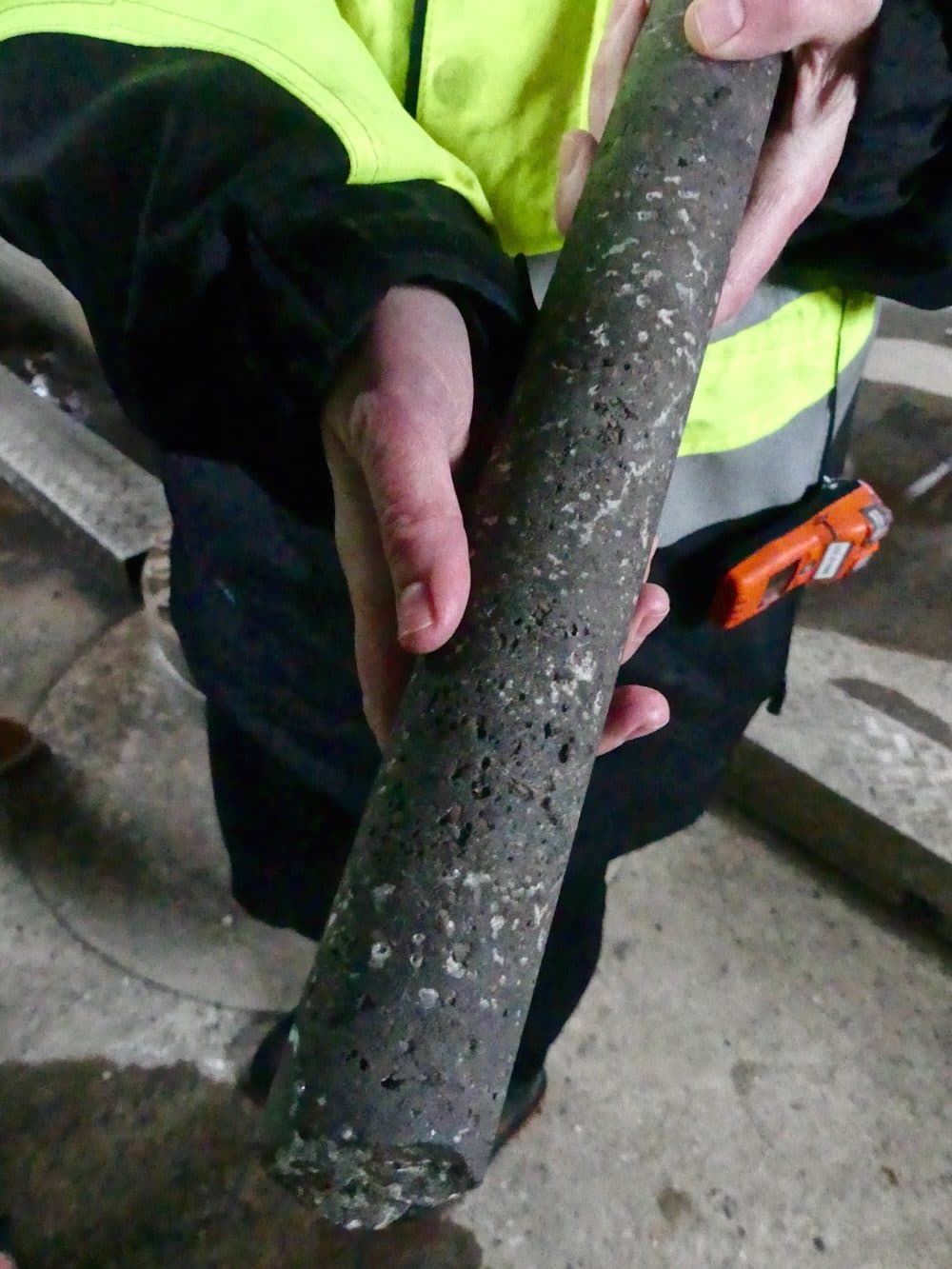Advertisement
Covering Climate
Researchers In Iceland Can Turn CO2 Into Rock. Could It Solve The Climate Crisis?

Editor's note: This segment was rebroadcast on Nov. 8, 2021. Find that audio here.
Strokkur in Iceland's Haukadalur valley is one of the world's most active geysers, erupting like clockwork every 10 minutes or so, sending plumes of steaming hot water up to 65 feet into the air. Like other geysers, Strokkur is propelled by underground magma, an intense heat source close to the Earth's surface.
All over Iceland, steam rises up from underground. The nation's geothermal plants tap into this source to heat water and homes. Tourists who have been to Iceland's Blue Lagoon pools bathe and luxuriate in the runoff water from a nearby geothermal plant.
But it's what's being done at the sleekly modern Hellisheiði geothermal plant, sitting on a bleak and black volcanic plain half an hour outside of the capital Reykjavík, that's creating buzz among scientists around the globe.
A team of young researchers there is capturing carbon dioxide emissions from the plant and infusing it into basalt rock that lines these volcanic plains.
Unlike previous capture and injection attempts, these emissions don't leak out. Instead, it becomes a non-polluting organic part of the underground landscape.
It's a raw windy day, sleet pelting, when we visit the so-called Carbfix project. We're issued hard hats and protective gear before we head out by car with Kári Helgason, the project's manager. He gestures out the window at a small, white Swiss prototype carbon injection well, housed in a white shack.
“This is the little one," he says. "We call it the Arctic Fox."
Sandra Ósk Snæbjörnsdóttir, the geoscientist at the helm of Carbfix, laughs, noting that it looks a little like an outhouse.
It’s small but mighty, says Andri Magnason, an Icelandic environmentalist, poet and cultural icon.
"This captures 50 tons [of C02] a year," he says. "To get 1,000 gigatons out of the atmosphere, we have to scale this up not 1 million times, but 1 billion times.”
Advertisement
“If you fly to Europe and back it will take this unit about a week to offset your emissions,” Helgason adds.
That's why there's so much excitement about the newer, larger Carbfix injection wells that can capture 1,000 times more emissions. And if it were to run at that capacity, ‘then we have solved the climate crisis,” Magnason says.
We ask Helgason about the rocks we're walking on.
"This is all volcanic rock. If you pick one up for example it's like Swiss cheese. There's a lot of porosity and a lot of holes,” he says. “So this is also what we have underground. It's what gives us the possibility to put the C02 underground. The space is there."
For the Carbfix system to work, Helgason says, "you need a lot of water, it can be seawater. You need favorable rock formations. And you need C02.”
All simple, he says, except "we're lacking the stream of C02."
The process does work, but Iceland’s geothermal plants produce clean energy, meaning the amount of C02 it captures is minimal. The team is thirsty for more polluting emissions to inject into rock.
“We need to catch it where it flows from the chimneys," Helgason says.
“If we're going to scale this up a million times, there will be millions of jobs created,” Magnason says.
"It will be scaled up," Helgason adds. "We know it's going to be scaled up. The question is whether it will be scaled up enough. And how fast.”
As people across the globe begin to take the climate crisis more seriously, Magnason speculates about what coming years will look like. “So in the future you will have capturing equipment on chimneys of the world and gas ships sailing to harbors where it will be pumped down with maybe seawater."

Soon, we arrive at a series of buildings that resemble igloos. Among them are wells retrofitted to inject CO2 into the ground — the world’s most advanced carbon injection wells. Inside are a series of pipes, valves and cranks; in the center of the room, a long pipe arm reaches deep into the cement floor.
Snæbjörnsdóttir explains why basalt rock is the gold standard for C02 injection, and why sedimentary rock, used on previous CO2 injection projects, is ineffective. Sedimentary rock, she says, contains softer material that gets washed away leaving only silica behind.
It's also not reactive. But basalt rock contains metals that are needed to react with the C02 and turn it into stone. To facilitate the process, she explains, Carbfix infuses the CO2 with water, killing the gas' buoyancy. Then, she says, "it sinks instead of rising up."
Snæbjörnsdóttir walks to a metal piping system she calls the wellhead, which reaches 2,000 meters below. One pipe infuses the water while the other, which reaches down 800 meters, injects the C02.

She walks to the windowsill and picks up a pipe-shaped black rock formation, flecked with what look like white crystals.
"The dark rock is just the basaltic rock," she says. "The white precipitates are actually C02 turned to stone."
It's a biblical image — researchers are taking one of the most dangerous drivers of climate change and turning it into stone.
Magnason reiterates that the problem here isn't that it doesn't work — it does! It's that more emissions are needed to thwart worldwide temperature increases.
"But if you have a coal-fired power plant and it can fill a tank ship, then the hard work is over,” he says. “Then you can pump it into basalt anywhere in the world where you have that. So the infrastructure that the 21st century will make, and it has to be as big as sewage or road systems, has to be C02 removal."
Helgarson and Snæbjörnsdóttir nod in agreement. Helgarson says that carbon-emitting plants have to start assessing whether this type of process can work at their current locations. If not, "then we can start thinking about transporting it to favorable rock formations, like in Iceland."
"This seems to be a real, plausible solution if this is scaled up properly and the price seems favorable," Magnason adds.
The issue of cost is an important one, Snæbjörnsdóttir agrees.
"Up until now, it's been cheaper to do nothing that to do something about your emissions," she says.
But she says that's changing: Soon it will be more expensive to emit. Prices of quotas in the European systems are rising, she says, "and now it's approximately the same price for doing this as doing nothing."
Helgason says that industry is starting to approach the team and asking about how to become involved.
"Even though Iceland is perfect for this," Snæbjörnsdóttir says, "... we can find big fields of basalt all over the world. It's actually the most common kind of rock on Earth."
She adds that in locations without basalt, there is often already an infrastructure in place that could help. "We have the know-how," she says, and, "We have a lot of wells from the search of oil, and lots of unused wells that could be used for injecting."
In other words, the infrastructure now in place for fracking and for transporting oil could be used to pipe emissions to locations where it could be infused into rock and neutralized.
Finally, adds Snæbjörnsdóttir, there's a misconception that because Carbfix is housed at a geothermal plant, it means hot water is needed for the injection process. In fact, she clarifies, cold water is more effective.
This segment aired on December 10, 2019.

